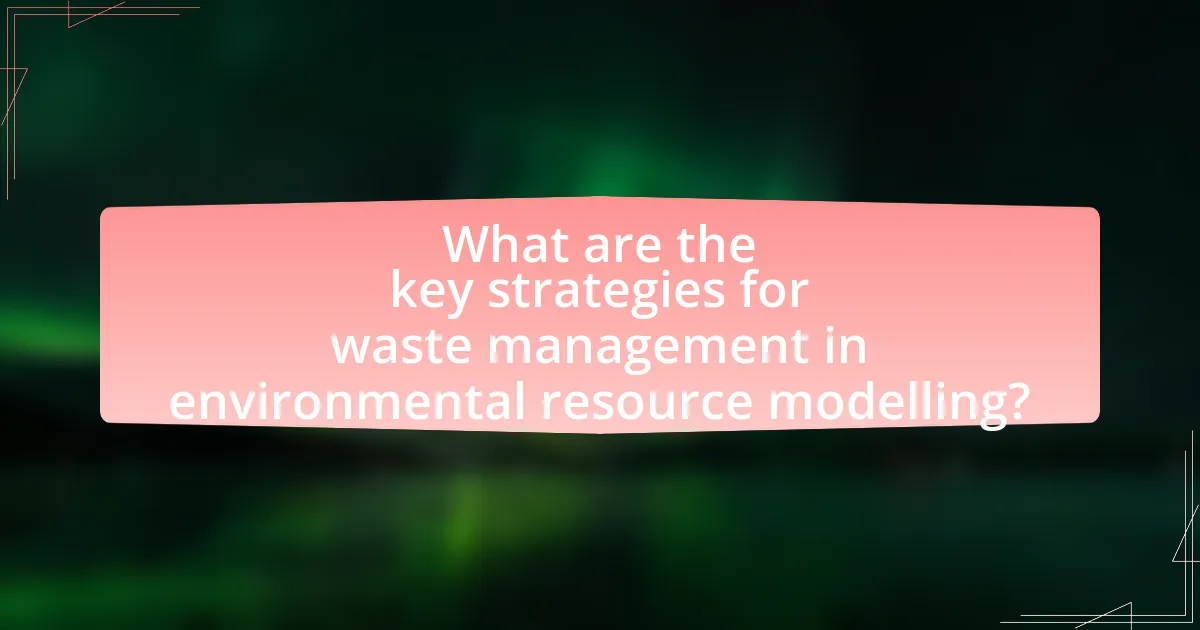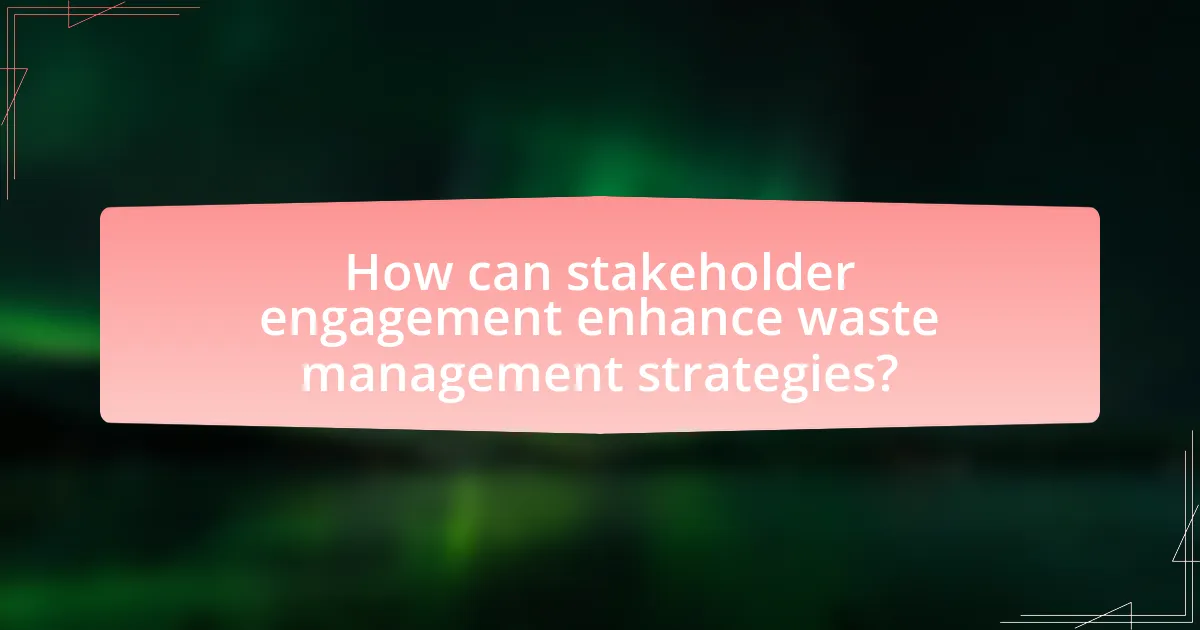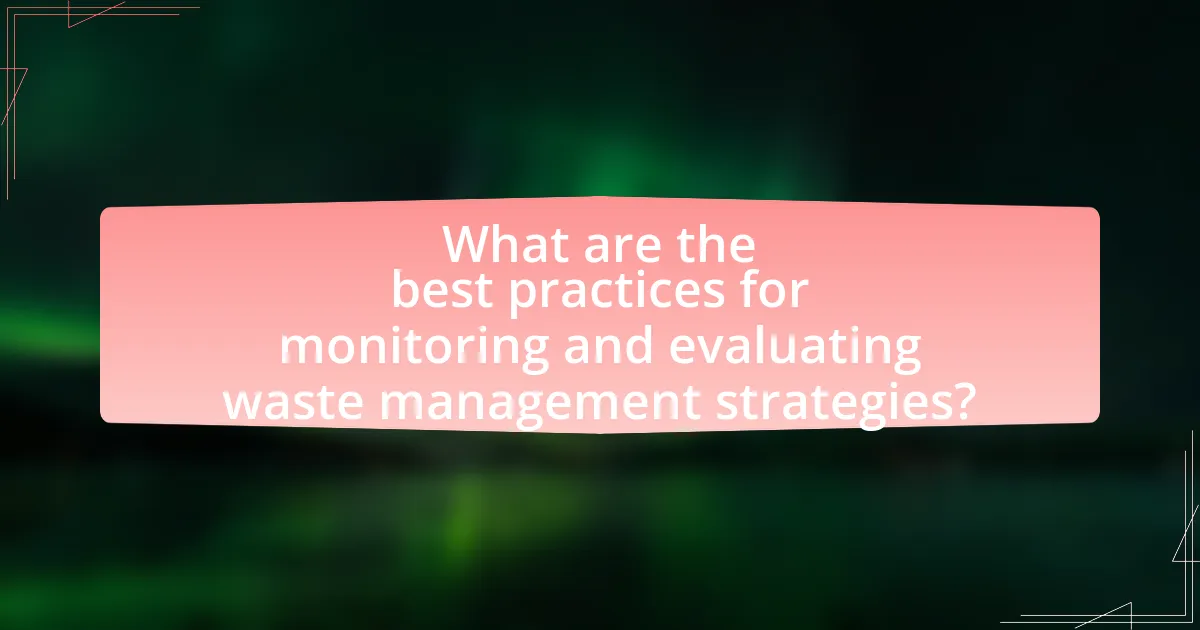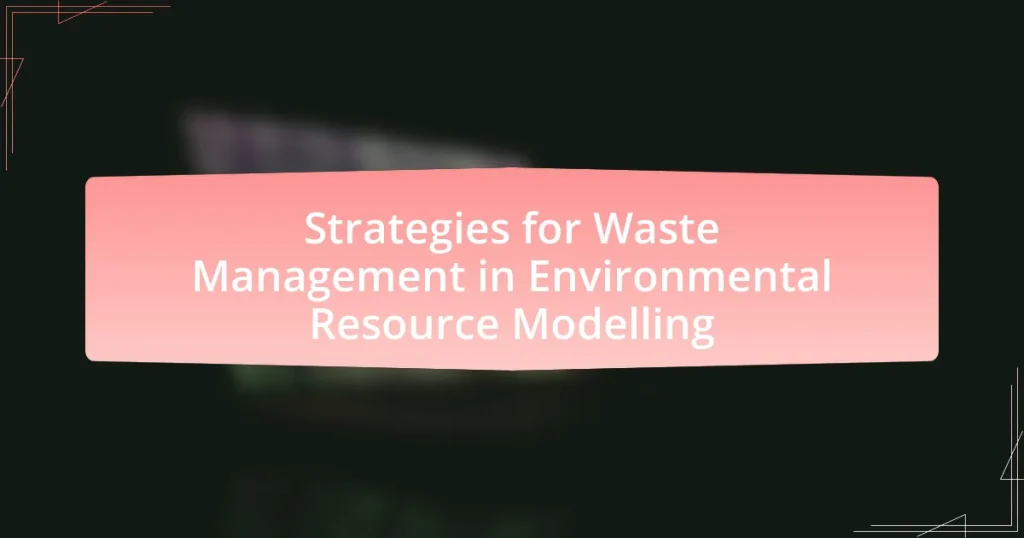The article focuses on strategies for waste management in environmental resource modeling, emphasizing key approaches such as waste reduction, recycling, and sustainable practices. It outlines how these strategies contribute to sustainable development by minimizing environmental impact and promoting resource efficiency, while also discussing the role of waste reduction and recycling in effective waste management. Challenges in implementation, the impact of regulatory frameworks, and the importance of stakeholder engagement are examined, along with technological advancements that support waste management efforts. Additionally, the article highlights best practices for monitoring and evaluating waste management strategies, including the use of data collection and software solutions to enhance tracking and reporting.

What are the key strategies for waste management in environmental resource modelling?
Key strategies for waste management in environmental resource modelling include waste reduction, recycling, and the implementation of sustainable practices. Waste reduction focuses on minimizing the amount of waste generated at the source, which can be achieved through efficient resource use and process optimization. Recycling involves converting waste materials into new products, thereby conserving resources and reducing landfill use. Sustainable practices, such as composting and the use of biodegradable materials, further enhance waste management efforts by promoting environmental health. These strategies are supported by data indicating that effective waste management can significantly reduce environmental impact and improve resource efficiency.
How do these strategies contribute to sustainable development?
Strategies for waste management contribute to sustainable development by minimizing environmental impact and promoting resource efficiency. Effective waste management practices, such as recycling, composting, and waste-to-energy technologies, reduce landfill use and lower greenhouse gas emissions. For instance, recycling can save up to 95% of the energy required to produce new materials from raw resources, significantly decreasing the carbon footprint associated with production processes. Additionally, these strategies foster a circular economy, where materials are reused and repurposed, thus conserving natural resources and reducing pollution. Implementing these waste management strategies aligns with the United Nations Sustainable Development Goals, particularly Goal 12, which aims to ensure sustainable consumption and production patterns.
What role does waste reduction play in these strategies?
Waste reduction is a fundamental component of strategies for waste management in environmental resource modeling. It minimizes the volume of waste generated, thereby reducing the environmental impact associated with waste disposal and resource extraction. Effective waste reduction strategies can lead to significant decreases in landfill use, lower greenhouse gas emissions, and conservation of natural resources. For instance, the U.S. Environmental Protection Agency reports that reducing waste by just 1 ton can prevent the release of 1.17 tons of carbon dioxide equivalent into the atmosphere. This demonstrates that waste reduction not only supports sustainability goals but also enhances the efficiency of resource management systems.
How can recycling be integrated into waste management strategies?
Recycling can be integrated into waste management strategies by establishing comprehensive recycling programs that include collection, processing, and education. These programs can enhance resource recovery, reduce landfill waste, and promote sustainable practices. For instance, cities that implement dual-stream recycling systems, where recyclables are separated from general waste, have reported increases in recycling rates by up to 30%. Additionally, public awareness campaigns can inform residents about proper recycling practices, further improving participation and effectiveness.
What are the challenges faced in implementing these strategies?
The challenges faced in implementing waste management strategies in environmental resource modeling include insufficient funding, lack of stakeholder engagement, and inadequate data availability. Insufficient funding limits the ability to develop and maintain effective waste management systems, as evidenced by studies indicating that financial constraints are a primary barrier to successful implementation. Lack of stakeholder engagement can lead to resistance and ineffective collaboration, which is critical for the success of these strategies. Additionally, inadequate data availability hampers the ability to make informed decisions, as highlighted by research showing that data gaps can significantly undermine the effectiveness of waste management initiatives.
How do regulatory frameworks impact waste management strategies?
Regulatory frameworks significantly shape waste management strategies by establishing legal requirements and standards that organizations must follow. These frameworks dictate how waste is collected, treated, and disposed of, influencing operational practices and resource allocation. For instance, regulations such as the Resource Conservation and Recovery Act (RCRA) in the United States set guidelines for hazardous waste management, compelling companies to adopt safer disposal methods and invest in recycling technologies. Compliance with these regulations often leads to improved waste reduction practices and encourages innovation in waste management solutions, as organizations seek to meet or exceed regulatory expectations.
What technological advancements support waste management efforts?
Technological advancements that support waste management efforts include smart waste collection systems, waste-to-energy technologies, and advanced recycling methods. Smart waste collection systems utilize sensors and IoT technology to optimize collection routes, reducing fuel consumption and operational costs. Waste-to-energy technologies convert non-recyclable waste into usable energy, with facilities like the Amsterdam Waste-to-Energy Plant generating electricity for thousands of homes. Advanced recycling methods, such as chemical recycling, enable the breakdown of plastics into their original monomers, allowing for higher quality recycling and reducing landfill waste. These advancements collectively enhance efficiency, sustainability, and resource recovery in waste management practices.

How can stakeholder engagement enhance waste management strategies?
Stakeholder engagement enhances waste management strategies by fostering collaboration and ensuring that diverse perspectives are considered in decision-making processes. Engaging stakeholders, such as local communities, businesses, and government agencies, leads to more effective waste management solutions that are tailored to specific needs and conditions. For instance, a study by the United Nations Environment Programme highlights that involving stakeholders can improve compliance with waste management regulations and increase public awareness, ultimately leading to higher recycling rates and reduced waste generation. This collaborative approach not only builds trust but also encourages shared responsibility, making waste management initiatives more sustainable and effective.
What methods can be used to involve local communities?
To involve local communities in waste management strategies, participatory approaches such as community workshops, surveys, and focus groups can be utilized. These methods encourage active engagement and allow community members to voice their concerns and ideas, fostering a sense of ownership over local waste management initiatives. Research indicates that when communities are involved in decision-making processes, the effectiveness of waste management programs increases, as seen in case studies where local input led to tailored solutions that addressed specific community needs.
How does public awareness influence waste management practices?
Public awareness significantly influences waste management practices by promoting responsible behavior and encouraging community participation. When individuals are informed about the environmental impacts of waste, they are more likely to engage in recycling, composting, and reducing waste generation. Studies indicate that communities with higher levels of public awareness report increased recycling rates; for instance, a survey by the Environmental Protection Agency found that public education campaigns can lead to a 20-30% increase in recycling participation. This correlation demonstrates that informed citizens are more proactive in adopting sustainable waste management practices, ultimately leading to improved environmental outcomes.
What partnerships are essential for effective waste management?
Effective waste management relies on partnerships between local governments, private waste management companies, non-governmental organizations (NGOs), and community groups. Local governments provide regulatory frameworks and infrastructure, while private companies offer expertise in waste collection and recycling technologies. NGOs often play a crucial role in raising awareness and promoting sustainable practices, and community groups facilitate grassroots engagement and participation in waste management initiatives. These collaborations enhance resource efficiency, improve recycling rates, and foster community involvement, ultimately leading to more effective waste management outcomes.
What role do businesses play in waste management strategies?
Businesses play a crucial role in waste management strategies by implementing sustainable practices that reduce waste generation and promote recycling. They contribute to waste management through the adoption of eco-friendly production processes, which minimize waste at the source, and by investing in technologies that enhance waste sorting and recycling efficiency. For instance, according to the World Economic Forum, companies that adopt circular economy principles can reduce waste by up to 80%, demonstrating the significant impact of business practices on waste management outcomes. Additionally, businesses often collaborate with local governments and organizations to develop community recycling programs, further enhancing their role in effective waste management strategies.
How can corporate social responsibility initiatives improve waste management?
Corporate social responsibility (CSR) initiatives can improve waste management by promoting sustainable practices and encouraging companies to adopt waste reduction strategies. By integrating CSR into their operations, businesses can implement recycling programs, reduce single-use plastics, and invest in waste-to-energy technologies. For instance, a study by the World Economic Forum found that companies with strong CSR commitments are 20% more likely to engage in sustainable waste management practices. This commitment not only enhances a company’s reputation but also leads to measurable reductions in waste generation and improved resource efficiency.
What incentives can encourage businesses to adopt sustainable practices?
Financial incentives, such as tax breaks and grants, can encourage businesses to adopt sustainable practices. These incentives reduce the financial burden associated with implementing eco-friendly technologies and processes. For instance, the U.S. government offers the Investment Tax Credit, which allows businesses to deduct a percentage of the cost of solar energy systems from their federal taxes, promoting renewable energy adoption. Additionally, companies that implement sustainable practices may benefit from improved brand reputation and customer loyalty, as consumers increasingly prefer environmentally responsible brands. Research indicates that 66% of global consumers are willing to pay more for sustainable brands, highlighting the market advantage of adopting such practices.

What are the best practices for monitoring and evaluating waste management strategies?
The best practices for monitoring and evaluating waste management strategies include establishing clear performance indicators, conducting regular audits, and engaging stakeholders in the evaluation process. Clear performance indicators, such as recycling rates and waste diversion percentages, provide measurable benchmarks for assessing the effectiveness of waste management initiatives. Regular audits, which can be conducted annually or biannually, help identify areas for improvement and ensure compliance with regulations. Engaging stakeholders, including community members and local businesses, fosters transparency and encourages feedback, which can enhance the overall effectiveness of waste management strategies. These practices are supported by studies indicating that comprehensive monitoring leads to improved waste management outcomes and increased community participation.
How can data collection improve waste management outcomes?
Data collection can significantly improve waste management outcomes by enabling informed decision-making and optimizing resource allocation. Accurate data on waste generation, composition, and disposal methods allows municipalities and organizations to identify trends, assess the effectiveness of current practices, and implement targeted interventions. For instance, a study by the World Bank in 2018 highlighted that cities utilizing data analytics for waste management saw a 20% reduction in operational costs and improved recycling rates by 15%. This demonstrates that systematic data collection not only enhances operational efficiency but also fosters sustainable practices in waste management.
What metrics are most effective for assessing waste management success?
The most effective metrics for assessing waste management success include recycling rates, waste diversion rates, and landfill diversion rates. Recycling rates measure the percentage of waste materials that are processed and reused, indicating the effectiveness of recycling programs. Waste diversion rates assess the total amount of waste diverted from landfills through recycling, composting, and other methods, reflecting overall waste management efficiency. Landfill diversion rates specifically focus on the reduction of waste sent to landfills, providing insight into the sustainability of waste management practices. These metrics are supported by data from the Environmental Protection Agency, which highlights that communities with higher recycling and diversion rates typically experience reduced environmental impact and improved resource recovery.
How can feedback loops be established for continuous improvement?
Feedback loops can be established for continuous improvement by implementing systematic processes for collecting, analyzing, and acting on feedback from stakeholders. This involves creating structured channels for communication, such as surveys or regular meetings, to gather insights on performance and areas for enhancement. Research indicates that organizations that actively engage in feedback mechanisms, such as the study by London Business School, demonstrate a 20% increase in operational efficiency due to iterative improvements based on stakeholder input. By integrating feedback into decision-making processes, organizations can adapt strategies effectively, ensuring ongoing refinement and optimization in waste management practices within environmental resource modeling.
What tools and technologies are available for waste management evaluation?
Various tools and technologies are available for waste management evaluation, including Geographic Information Systems (GIS), waste management software, and remote sensing technologies. GIS enables spatial analysis of waste generation and disposal patterns, facilitating better planning and decision-making. Waste management software, such as WasteLogics and Envirosuite, provides data tracking, reporting, and optimization of waste collection routes. Remote sensing technologies, including satellite imagery and drones, allow for real-time monitoring of waste sites and environmental impacts. These tools collectively enhance the efficiency and effectiveness of waste management strategies.
How can software solutions enhance waste tracking and reporting?
Software solutions can enhance waste tracking and reporting by automating data collection and analysis, leading to improved accuracy and efficiency. These systems utilize sensors and IoT technology to monitor waste generation in real-time, allowing organizations to gather precise data on waste types and volumes. For instance, a study by the Environmental Protection Agency indicates that automated tracking can reduce reporting errors by up to 30%, facilitating better compliance with regulations. Additionally, software platforms can generate detailed reports and visualizations, enabling stakeholders to make informed decisions based on accurate waste management metrics. This integration of technology not only streamlines operations but also supports sustainability goals by identifying areas for waste reduction and resource recovery.
What role does GIS play in waste management analysis?
GIS plays a crucial role in waste management analysis by enabling the visualization, analysis, and management of spatial data related to waste generation and disposal. It allows for the identification of optimal locations for waste facilities, analysis of waste collection routes, and assessment of environmental impacts. For instance, studies have shown that GIS can improve route efficiency for waste collection by up to 20%, leading to reduced operational costs and lower carbon emissions. Additionally, GIS facilitates community engagement by providing accessible maps and data, which helps stakeholders make informed decisions regarding waste management strategies.
What practical tips can be applied for effective waste management in environmental resource modelling?
Effective waste management in environmental resource modelling can be achieved through several practical tips. First, implementing a comprehensive waste audit helps identify the types and quantities of waste generated, enabling targeted reduction strategies. Second, adopting the principles of the waste hierarchy—reduce, reuse, recycle—ensures that waste is managed in the most environmentally friendly manner. Third, utilizing advanced modelling software can enhance the accuracy of waste projections and management strategies, allowing for better decision-making. Lastly, engaging stakeholders in the waste management process fosters collaboration and innovation, leading to more effective solutions. These strategies are supported by studies indicating that systematic waste audits can reduce waste by up to 30%, and stakeholder engagement has been shown to improve compliance and sustainability outcomes.


